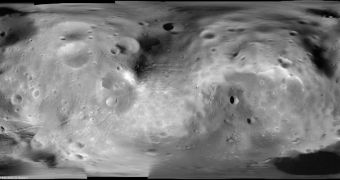On March 3, the European Space Agency (ESA) orbiter Mars Express conducted the closest flyby ever of the Martian moon Phobos. At the point of closest approach, the spacecraft was just 67 kilometers above the surface of this enigmatic moon, which has never been surveyed in such vivid detail before. Previous investigations have revealed that it does not have enough mass to be a fully-solid space rock, which means that it could be made up of loosely-bound boulders and other rocks. The new measurements collected by Mars Express will be used to assess this possibility.
This will be done by carefully analyzing the radio signals that the orbiter sent back. In order to assess the gravitational pull of Phobos, and therefore its mass, researchers did not do anything specific to their spacecraft, except lock it on a radio signal sent from Earth. This was achieved at 21:20 CET (20:20 UTC). What the team did next was basically to receive a constant signal from the orbiter. But there was also a catch. Depending on how much pull the moon exerted, the radio signal oscillated briefly. By analyzing these variations, experts hope to be able to draw conclusions on how the space rock influenced the spacecraft.
Now, that the investigation into the new datasets has begun, experts hope to be able to conclude precisely how much of Phobos's interior is made of caverns. “Phobos is probably a second-generation Solar System object,” explains the principal investigator of the Mars Radio Science (MaRS) experiment, Martin Patzold. He also holds an appointment at the Universitat Koln, in Cologne, Germany. If the moon is a second-generation body, then it formed in Mars' orbit after the planet itself solidified, rather than coalescing from the same initial batch of matter.
“Whatever the precise origin, Phobos will eventually crumble back into this disrupted state. It is gradually spiraling towards Mars and will eventually be pulled apart,” the expert adds. ESA scientists believe that the Red Planet is gradually pulling the moon closer and closer. Eventually, the gravitational forces exerted on the rock will become so large, that the weak interactions keeping the space debris together will be exceeded by a large margin. When this happens, Phobos will fall apart, with the debris most likely falling to the Martian surface.

 14 DAY TRIAL //
14 DAY TRIAL //